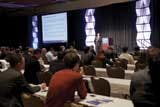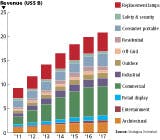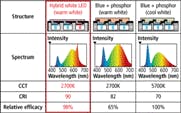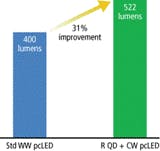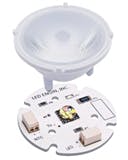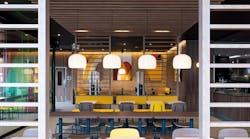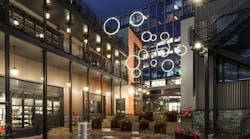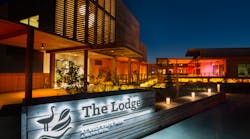This article was published in the March 2013 issue of LEDs Magazine.
View the Table of Contents and download the PDF file of the complete March 2013 issue, or view the E-zine version in your browser.
+++++
"What would a lighting solution look like if we had never had the Edison bulb," asked Anna Weiner Jiffer, business area manager for global lighting at Ikea. "Do you think we would have lamp shades? Probably not." Jiffer’s question followed a recurring theme at the recent Strategies in Light (SIL) conference as speakers consistently questioned when the lighting industry will truly take advantage of LED sources and eschew old forms such as the light bulb and legacy luminaires designed around bulbs. Moreover LED are poised to bring new capabilities to lighting, both in the form of controls that we have discussed before, but also in terms of expanding how we utilize and experience lighting.The experts are in agreement that while LED technology will continue to improve, the technology is plenty good enough to serve as the predominant light source today. In one of the keynote speeches during the opening Plenary Session, Norbert Hiller, senior vice president of Cree reported that he is no longer asked if LEDs can replace legacy lighting. He said, "It’s only a question of when and how." That type of thinking was evident even going back to Lightfair last year. At Lightfair, however there was a prevailing feeling that the lighting industry was moving relative quickly. Perhaps the SIL attendees have a longer history with LEDs, because the solid-state lighting (SSL) advocates at the show were predicting a quick saturation of the market for LED retrofit lamps and the need for revolutionary new lighting forms.
Other common themes at SIL included new approaches to driving LEDs, standards and regulatory issues, and tunable lighting – both tuning white SSL products for specific CCTs and full color tuning. The program included updates on modular LED technologies, and networks and controls were mentioned as necessary to broader SSL deployment right alongside the need for a fresh approach to designing LED-based lighting products.
SIL Plenary and keynotes
Along with a packed exhibit floor (Fig. 1), the 3013 SIL conference featured dual LED and Lighting Technology and Market Tracks along with the Plenary session, an LED Manufacturing Track, Workshops and an Investor Forum. We will cover some talks from the Market and Technology Tracks, Investor forum, and Plenary session here.
Cree’s Hiller (Fig. 2) presented a quick look at the pace of LED advancements and discussed future performance. He said Cree announced its first 12W downlight that used 42 LEDs in 2007 with a wholsesale price over $100. In 2012, a similar 10.5W product required eight LEDs. The newest such product, selling for $30 at retail, uses five LEDs and dissipates 9.5W. The advancements come courtesy of brighter LEDs, but more significantly LEDs with higher efficacy.
The efficacy advantage is easily illustrated in the form of a graph (Fig. 3). The figure shows the advantage one of Cree’s newest LEDs, the XM-L2, enjoys over the XP-G, a widely-used Cree LED that has been available for several years. Moreover, the figure shows the additional reduction that a system design can realize in LED count by trading off a small amount of efficacy.
During his keynote, Hiller revealed that Cree had achieved efficacy of 276 lm/W in the lab, up from a milestone of 254 lm/W announced last April. When pressed for details, Hiller said the demonstration was based on a LED with CCT in the 4000K range. Moreover he said the LED was operated at 350 mA of drive current.
Hiller did say that SSL product designs still need to better leverage the LED light source. Too many products still look like legacy products. He said a full efficiency advantage requires fixtures that are optimized for LEDs.
Moreover, Hiller reminded that we are very early into the SSL transition and LEDs are addressing perhaps 10% of the lighting market. As an example he mentioned the recent Superbowl football game and the lengthy delay resulting from a temporary power loss and the long restrike period of the HID lights. He quipped, "This is a perfect opportunity we should try and get this [lighting] replaced with LEDs."
Nakamura’s vision
Keynoter Shuji Nakamura, inventor of the blue LED, also took a look forward at the evolution of the LED and what types of components might be available by 2020. Nakamura is a professor at the University of California at Santa Barbara (UCSB) and research director of the school’s Solid State Lighting and Energy Center. He focused on what he called LED 2.0 which he defined as LEDs manufactured with homo-epitaxial growth – primarily gallium-nitride (GaN) LEDs grown on GaN substrates.
Nakamura is also a cofounder of Soraa and that company is focused on GaN-on-GaN LEDs based in part on Nakamura’s research at UCSB. Not surprisingly, the presentation was somewhat Soraa centric. Indeed Nakamura said that Soraa’s latest LEDs have, in the lab, produced the highest documented external quantum efficiency (EQE) in the industry at current densities greater than 100 A/cm2.
The LEDs have peak EQE of 73%. Nakamura explained that the homogenous material match results in 1000 times fewer defects. Moreover, the match means that the GaN substrate can be left in place and the thicker substrate, with a refractive index that matches the LED structure, optimizes light extraction.
Ultimately, however, Soraa will have to overcome the higher cost of GaN wafers to find success. Nakamura pointed out that one cost reduction will come from the ability to make more LEDs per wafer because the GaN-on-GaN LEDs are ten times brighter than hetero-epitaxial LEDs grown on sapphire, silicon carbide, or silicon. Nakamura showed an LED with a triangular foot print that he said was 15 to 25 times smaller than typical high-power LEDs.
Nakamura did address lighting as well and said quality of light would be the driver of SSL market adoption. Indeed Nakamura and Soraa have been spearheading an industry movement asking the US Environmental Protection Agency (EPA) to lower Energy Star efficacy requirements for lamps with CRI of 90 or above (page 22). The group argues that specifiers are more likely to use higher-quality lights and that lowering the cost of 90-CRI products through slightly lower efficacy can ultimately expand SSL usage and increase overall energy savings.
High-efficacy warm white
MJ Jou president of Epistar, provided the final keynote of the Plenary, and spent much of his talk discussing how the industry can raise the efficacy in the warm-white SSL products that are most desired by lighting designers. He started by discussing the US Department of Energy (DOE) roadmap for LEDs that addresses both cost and efficacy goals.
The DOE had projected that LEDs would hit a price point of $2.20/klm (dollars per kilo lumen) for warm white LEDs and $2/klm for cool white LEDs in 2015. The industry has far outperformed that projection. Jou said-plastic packaged LEDs are already selling for $2/klm echoing a similar statement made by Strategies Unlimited’s Ella Shum (page 35).
In terms of efficacy, the DOE has projected that by 2020 warm-white LED will nearly match cool-white LEDs. Today however, and even through 2015, cool white LEDs are projected to have 10-15% higher efficacy. The lower efficacy in warm white LEDS is attributable to the fact that red phosphors generate significant energy in the infrared spectrum and that is essentially wasted energy in terms of the human eye. But energy in the red wavelengths is required for warm white CCTs.
Jou discussed what Epistar calls a hybrid-white approach to warm white CCTs or Direct Red – mixing red LEDs and phosphor-converted blue LEDs. Adding red or amber LEDs into an SSL design to achieve efficient warm-white performance is not a new idea. It was first adopted by Cree in TrueWhite and more recently by Osram in Brilliant Mix, although both are essentially implemented at the SSL system level. But Jou showed an illustration of a packaged LED that would mix emitters and presumably make the technology more widely available to lamp and luminaire manufacturers. Questioned later, Jou said such a multi-emitter package could be fully covered in the phosphor required to make the white light, or that blue emitters could be phosphor coated while the red ones were not.
Mixing red LEDs The key to high efficacy therefore becomes a red LED with very high efficacy. Jou said that in late 2012, Epistar achieved 182 lm/W in a red LED, and suggested that the performance matched the best red LEDs from any manufacturer. Jou said that the Direct Red technology could soon deliver a warm-white mid-power LED with efficacy in the 160 lm/W range, essentially matching cool-white efficacy. As Fig. 4 shows in relative terms, Jou believes that warm-white efficacy can quickly come within 2% of cool-white efficacy.Of course there is generally a price premium associated with mixing red and white LEDs. The red color and brightness shifts with temperature. So most such products uses a two channel driver with the red LEDs on a dedicated channel so that the driver can compensate for temperature shift. For example, Atmel announced a new driver IC at SIL for just such applications (page 18).
While Jou said the dual-channel approach was technically valid, he suggested it might not be cost-effective in some applications. He said Epistar was working on adding a thermally-variable resistor in parallel with Red LEDs so that the drive current would be automatically adapted as the temperature changes.
Indeed Jou had begun his talk stating "Innovation is one thing commercialization is another." And commercialization requires a system design that can deliver performance at the system level and reasonable end-product costs.
The route to efficient and cost-effective products is through mid-power emitters in high-voltage configurations according to Jou. He compared a pair of theoretical 2W LEDs, one of which was a single die driven a 0.6 A and a forward voltage of 3.3V, and the other comprised of a 50V stack of smaller LEDs driven at 40 mA. Either could produce 1200 lm. But Jou pointed out that the power conversion is far more efficient in the high-voltage case.
There is also an advantage in EQE, according to Jou, for the high-voltage configuration. He said, "The current spreading issue is really critical in an LED device." Jou, and Nakamura as well, said even current spreading is difficult to achieve as the size of an emitter increases. Jou said the array of smaller LEDs naturally spreads current and said the EQE advantage can be 15%.
QDs for warm white
Of course there are a number of approaches to warm-white LEDS and SSL products. At SIL, the subject of quantum dots (QDs) again surfaced relative to warm CCTs. Like phosphors, QDs emit energy when excited by photons from a blue LED. Startup Pacific Light Technologies (PLT) presented in both the Investor Forum and the Technology Track. In the Investor Forum, CEO Ron Nelson said QDs can improve optical efficiency 40-50% over phosphor-converted LEDs and double or triple lumens per dollar.
As discussed previously, the disadvantage of phosphor technology is that it has a relatively-wide spectral emission range. Red phosphors might emit over a 100-nm band, resulting in wasted infrared energy. Nelson said that PLT QDs can limit the emission to 20-40 nm ensuring that all of the energy is in the visual range.
There are several manufacturers pursuing QD technology including QD Vision that has previously presented at SIL. Nelson said that to date several roadblocks have presented widespread usage of QDs in commercial products. QDs can be sensitive to air and moisture, can have limited operating lifetime, and have been costly. Nelson said PLT has developed QDs that can be handled in air and that can be used with LED silicones, solving some key issues.
Assuming PLT delivers, the QD technology could deliver a significant efficacy gain. Nelson described a project with an early-stage customer working on a warm-white LED design with a CRI of 89. Fig. 5 summarizes the results. An LED with a cool-white phosphor combined with red QDs has achieved a 31% efficacy gain relative to a typical warm-white, phosphor-converted LED.Nelson said that PLT could deliver a QD mix that would yield a CRI of 96 using similar colors to the phosphors commonly used in LEDs. He said with a mix of 8 QDs, the company could enable an LED that can replicate the black-body curve.
Alas the question remains as to whether and when PLT, or another QD vendor, will deliver affordable and reliable QDs. In the Technology Track, PLT CTO Juanita Kurtin said the company plans commercialization in 2014.
Tunable packaged LEDs<
Turning back to more conventional approaches, LED Engin discussed using LED mixes both to deliver warm-white, high-CRI sources, and separately to deliver what it calls halogen-style dimming. Such dimming operation is also called dim-to-warm technology. President and CEO David Tahmassebi described a key change for the SSL industry as matching capabilities such as color tuning or high CRI to specific applications that might require it.
LED Engin does not manufacture LED die but rather buys die from other manufacturers and delivers multi-emitter packaged LEDs to customers. The company also offers the LEDs installed in complete modular light engines with driver electronics thus simplifying the design task for the LED manufacturer.
Over the coming months, the company is rolling out a new ViviLux family (Fig. 6) that will include 2700K and 3000K LEDs with a CRI of 90, and a LuxiTune family that will support tuning over the range of 2000K to 4500K with dim-to-warm capability. Both products use a proprietary mix of LED colors including red emitters. Tahmassebi revealed those plans for the first time publicly in the Investor Forum.
Multi-channel engines
Lumenetix, meanwhile, is focused on what Saake called "multi-channel spectral tuning." That approach mixes high-power, phosphor-converted white LEDS with three to ten channels of different colored LEDs. More channels deliver more even energy distribution across the visual spectrum. The result can be more accurate white light, or full color.
Saake argued that the market for such technology is much broader than the technical niche that some people place it in. He listed applications ranging from museums and medial to residential, where consumers might use the capability to light artwork or for wellbeing – replicating natural light.
Lumenetix has developed tunable, modular, light engines called Araya based on a five-channel LED architecture. The modules are also equipped with a wireless interface and Lumenetix developed a handheld remote to control the engines. Moreover you can use the remote to capture a color scene and transmit it to the Araya engine which will duplicate it.
SSL controls
Moving specifically into lighting controls, there were perhaps fewer controls-centric presentations at SIL this year, but the presence of adaptive controls going forward was simply implicit in many presentations. Kelly Cunningham of the California Lighting Technology Center at the University of California at Davis provided an update on a campus-wide lighting network covering pathway and exterior-building lighting. It’s an interesting story that we just covered in December.
The most compelling new information on controls and how deeply lighting and IT networks will mesh came from Brad Koerner, director of experience design at Philips Lighting, in a talk entitled "Reaching the next evolution in lighting." Fully embracing LED technology will involve the intersection of lighting technology, architecture and construction, and lighting design according to Koerner.
The technology segment will be the enabler. Koerner predicted than within a year or two, complete driver electronics will be miniaturized to IC size. Moreover the IC will include sensors and network support. He said that soon, "connecting full Internet Protocol all the way out to each and every light source will cost less on a total project basis than connecting older proprietary control protocols."
He said architects would like to treat lighting in the same way they treat materials such as glass or acrylics. And he said lighting designers want to embed light into architectural structures. Lighting becoming part of the so called Internet of things will help enable such a transition.
While we’ve heard the controls vision before, Koerner’s presentation took a surprising turn. He did mention that lighting becomes capable of presenting digital animation and other benfits. But he believes that intelligence and networks inherent in lighting will change the way that lighting is specified and that buildings are manufactured.
The architecture industry is already moving to Building Information Management (BIM) systems in which plans for a building are stored in models rather than in traditional drawn plans. The computerized approach enables what Koerner referred to as digital fabrication where more subsystems of a building are mass-produced remotely to a model specification and then assembled on site.
Koerner believes that lighting needs to follow a similar path. And having intelligent lighting, in which parametric data about the capability of the lighting product or module is stored locally in the product, would enable on-site fabrication of lighting systems— customized but based on mass production.
Specifically, Koerner mentioned the Zhaga Consortium standards, and referred to his vision as the paradox of standards. He said, "Standard modules enable mass customized lighting systems by reducing the development cost." But there are missing pieces. Clearly we need ubiquitous open rather than proprietary networks. And we need data standards for formatting and storing the parametric data on lighting products that feed he BIM system.
Long term, Koerner sees tracking the elements of a lighting system from component to final assembly in an automated fashion. He said LEDs are already tracked from wafer to package. The tracking and incremental buildup of parametric and commissioning data could continue through light engines or modules all the way to fixtures or architectural systems. He referred to the concept as nesting file standards .
Shorter term, Koerner believes that modules, and Zhaga in particular, can begin the process. He said, My gut feeling is that 2013 is the year for modules."
Modules – what flavor?
There were a number of SIL presentations that covered modules. And while most shared some of Koerner’s beliefs, the feelings were rather mixed on the Zhaga approach. Everyone seems to agree that modules can accelerate product development and enable LED usage in lower-volume applications. But not everyone believes that Zhaga’s approach to vendor interoperability will work with SSL.
Paul Scheidt, product marketing manager for LEDs at Cree, summed up the consensus saying, "Modules enable all lighting companies to use LEDs." But he also warned that SSL product designners still have to handle thermals and optics to yield optimal performance. Scheidt added, "Just because you are using an LED module, the fundamentals don’t change."
Cree sees modules as a stepping stone technology if you will. A company can use a module to bring a product to market. And products that succeed and that are headed to higher volume can be transitioned to custom-designed light engines. Scheidt said that the make vs buy decision turns into buy and then make only for successful products.
Thor Scordelis, global product marketing manager at Xicato, took a stronger aim at Zhaga, especially in regards to field replacement or service of a modular product. He said, "Interchangeable is not interoperable." Specifically Scordelis discussed the match between the driver and the light engine saying, "I see it as a matched set." He said if you replace one or the other you could incur regulatory safety issues. And even if the repaired product works, the lighting performance may differ.
Essentially Scordelis said LEDs and SSL are too much of a moving target right now for the concept of interchangeable light engines to work. He said that just as you would likely replace rather than repair a $1000 failed TV set right now, that most SSL products would be best treated the same way. There are exceptions such as in-grade lighting according to Scordelis that would be repaired. But he sees the bulk of the SSL landscape as a replacement market for the foreseeable future.
Driver design
While driver/light engine compatibility came up briefly in the modular discussion, driver-electronics design was a frequent topic throughout the sessions. Indeed there were quite a number of driver ICs announced at the conference and many of those are covered in our News + Views section (page 18). But driver compatibility with legacy dimmers and driver cost continue to be hot topics.
All of the IC vendors claim to have developed products at this point that work with phase-cut dimmers. In practice, it comes down to the specific dimmer and driver in question and even how many lamps are connected to the dimming circuit. We simply have no good way of quantifying driver compatibility with phase-cut dimmers.
James Hammond, CTO and cofounder of Indice Ecotech spoke during the Investor Forum and he noted that many drivers even have a problem with dimmers at the high end of the dimming scale. He said that most drivers in products on the market will only drive the LEDs at about 75% when the dimmer is set to full scale. In other words, a lamp on a circuit without a dimmer would appear noticeably brighter.
Of course Indice believes it has solved the problem going to much higher-frequency switching in the 1- to 3-MHz range in its switch-mode driver circuit, allowing the driver to adapt to dimmer and lamp conditions each switching cycle.
The topic of AC-LED technology continues to percolate with the allure of lower-cost electronics and less loss in the power conversion circuits. But a number of the products on the market don’t fully utilize the LED lumen capacity in products. Ray Martin, CEO of Advanced Lighting Technologies, presented a talk on capacitor-less drivers that was essentially an architecture for a high-voltage AC driver. But the circuit connects the LEDs in a long series string with multiple taps so that many of the LEDs are only driven near the peak of the AC waveform.
AC-drive techniques are also limited in many instances in supporting techniques for warm-white operation. Lynk Labs, however, exhibited its SnapBrite COB module announced in January that combines AC drive and warm-white capabilities through multiple LED channels.
Lighting consumers
Of course lighting consumers don’t really care about all of the technical details that the SSL industry must wade through. The consumer simply wants high-quality, energy-efficient light with perhaps some capabilities like color tuning that hasn’t been available before. That brings us back to Ikea. Jiffers pointed out that light is unique in that it can totally change the look and feel of a room, for example from a relaxed atmosphere to a bright and active one.
But Jiffers is worried about the evolution of the lighting industry and the impact of LEDs. She said, "My belief is that that it is customer need that should drive technology and not the other way around." Jiffers doesn’t profess to have the answers, but Ikea intends to be part of the journey through its "Future light at home program." Jiffers did say that Ikea wants to see luminaires with replaceable sources.
Ikea believes it can be a catalyst of change because its customers are more willing than the typical consumer to make environmentally-conscious choices. And Ikea is looking to engage with lighting vendors and help shape future products with the goal of having only LED lighting in its stores by 2015 after having already moved to sell only LED-based lamps.
While Jiffers seemed to nudge the SSL industry toward a different approach, Ted Konnerth, CEO of Egret Consulting, supplied a stern prod. Konnerth currently works as an executive recruiter but has a long history in the lighting business.
Konnerth questioned the ongoing retrofit of legacy lighting with SSL products. He questioned the wisdom of placing a "four-pound lamp in a 20-yr-old socket that has baked in a ceiling can." He also doesn’t see the sense in retrofitting linear lighting. He said troffers are really bad lighting and retrofitting them with LEDs just makes "a bad fixture worse."
Konnerth believes we need to rapidly move to new designs. He said, "You don’t need to pierce the ceiling anymore." We have recessed lighting purely because of the Edison bulb. In commercial spaces, Konnerth said plenum space is really expensive. If you can save 6-in in plenum space in each story of a 20-story building, you get a 21-story building according to Konnerth.
But Konnerth said there is little evidence of freedom of design in SSL thus far. He said "manufacturers are using the same castings that they have used for 30 years." And he added, "The Edison socket is dead, It’s not a power-supply distribution point." The future, according to Konnerth should be DC power supplied over Cat-5/6 wiring and low-profile fixtures that accentuate the LED source.

